Nomination Forms Toolkit – Scotland
This toolkit will help you fill out your nomination forms for Scottish Council Elections. This is the legal paperwork you must complete in order to stand in elections as a Liberal Democrat candidate on the ballot paper.
You can download your full pack of nomination papers from the Electoral Commission website here.
You should check your eligibility to stand in the forthcoming election. There are a number of criteria that make you eligible to stand, and a number of criteria that can also disqualify you from standing. You can check your eligibility with the Electoral Commission’s Guidance for Candidate’s and Agents here.
You should also arrange a date to go into the Elections Office at your Local Council a few days in advance of the deadline for submitting your nomination forms – and let them check that all your forms are correctly filled in. This will give you time to put right any errors before the deadline.
This toolkit will take you through each form you need to fill in as follows. You should complete your forms in BLACK INK and make efforts to make your writing as legible as possible.
Nomination Form
Home Address Form
Certificate of Authorisation
Request for a Party Emblem
Notification of an Election Agent
Nomination Form
First of all write the name of your Electoral ward in the first box at the top of the page. Then write the name of the Council in which you are standing. Finally write the Polling Day date in the third box right below.
The next section is where you can fill out your name and the party description that will appear on the ballot paper. You must fill out your surname and forenames as they appear on the electoral register. You may use a title; for example, if your actual name is Joseph Smith but your hereditary title is Joseph Avon, you can use the name Joseph Avon as your full name.
You are able to give a commonly used name – for instance, a candidate named Robert may reasonably appear on the ballot as Bob. The returning officer has the right to disallow any name which is deemed to be offensive or they feel is aiming to deceive the electorate. Similarly, a person known by a surname other than their legal surname (for instance, their surname before marriage which they keep professionally) may also ask for this commonly used surname to appear on the ballot.
Finally you need to add the party description – which is the Liberal Democrat description that will appear on the ballot paper. This must match the party name you give on your Certificate of Authorisation form. The options you have in Scotland are below and it is strongly recommended that you use ‘Scottish Liberal Democrats’ in Scottish elections.
- Scottish Liberal Democrats
- Scottish Liberal Democrat Focus Team
- Liberal Democrat
- Liberal Democrat Focus Team
- Liberal Democrats – For a fair deal
- Focus Team
The next section of the Nomination Form is where you confirm that you are eligible to stand as a candidate in the elections – either by confirming that you are on the electoral role within the Council area in which you are standing and/or by confirming that you work / own property / live in that Council area.
First of all you should fill out the Ward Name and Council Name to give your consent to being nominated.
The form then lists qualifying criteria that allow you to stand for election. You should cross through any that do not apply to you and leave those that do. For the criteria a) being a registered local government elector for the local government area named above as in the register of electors you should write you electoral role number that can be found on Connect or the Electoral Register for the Polling District in which you live.
Finally you need to sign and date this form, and then have a witness sign, print their name and date the form too. Please note that this has to the the same witness who signs the other forms you submit.
An example of a completed Nomination Form is below:
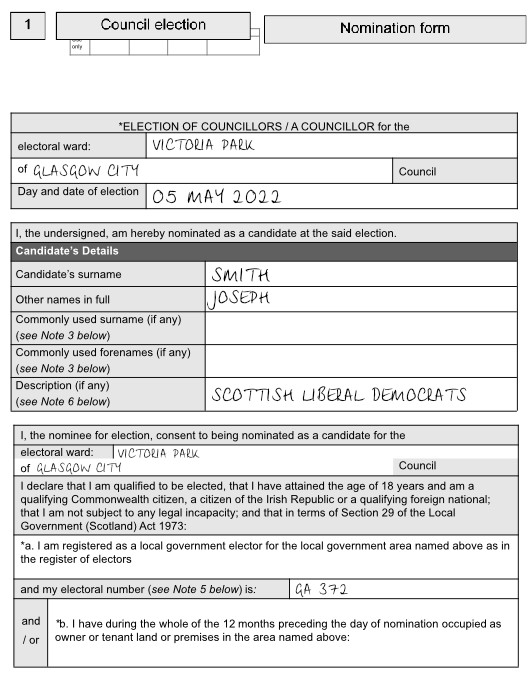
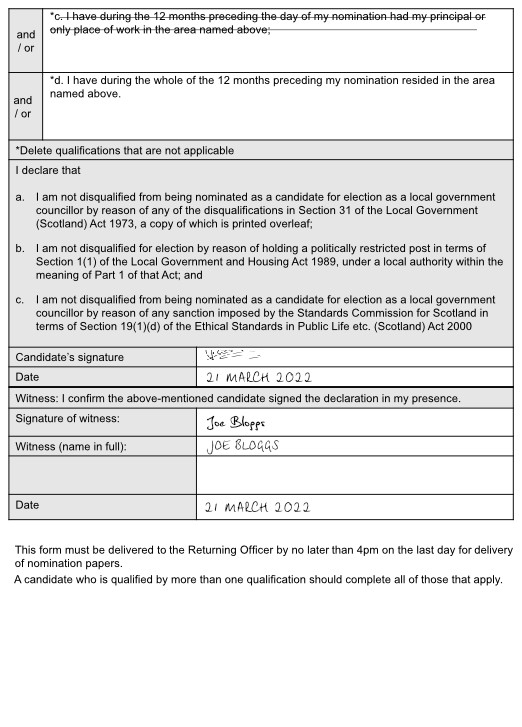
Home Address Form
The Home Address Form is where you provide your address information evidence of your eligibility to stand – either by demonstrating that you live within the Council area in which you are standing or by demonstrating that you work / own property / exist on the electoral register in that Council area.
It is split into two sections (Part 1 and Part 2). In Scotland you must complete and submit both sections of this form.
Part 1 – You must provide your full name and full home address. Then you should tick all of the qualifying criteria that apply to you that allow you to stand. These are the same criteria covered in the Nomination Form. For each that apply tick the accompanying box and then provide the full address or addresses that confirm that you meet this criteria.
Finally on Part 1 a witness needs to provide their full name and address. This must be the same witness who signed your nomination form above.
Part 2 – This is where you select whether you want your home address to appear on Ballot Papers and the Notice of Poll.
If you want your home address to be displayed on Ballot Papers you need to tick, sign and date the Statement section on Part 2 of the form. If you want to withhold your home address you must complete the section above this in which you must put the Council area in which you live (or country in which you live if you live outside of the UK).
An example Home Address Form, for a candidate wishing to display their home address on the ballot paper, is below:
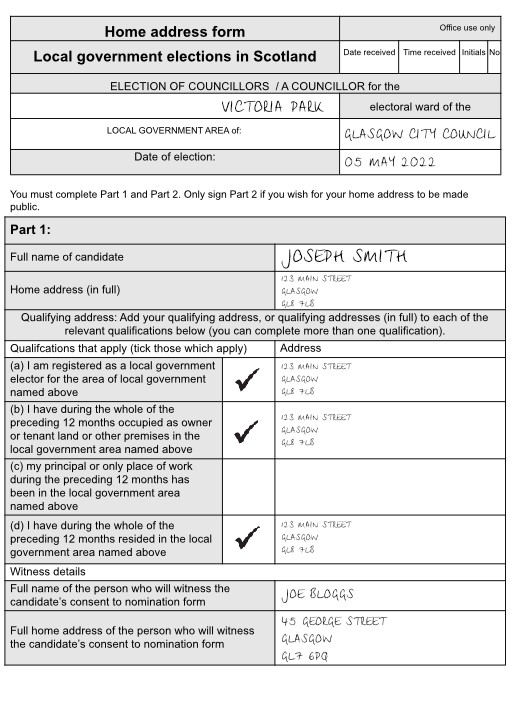
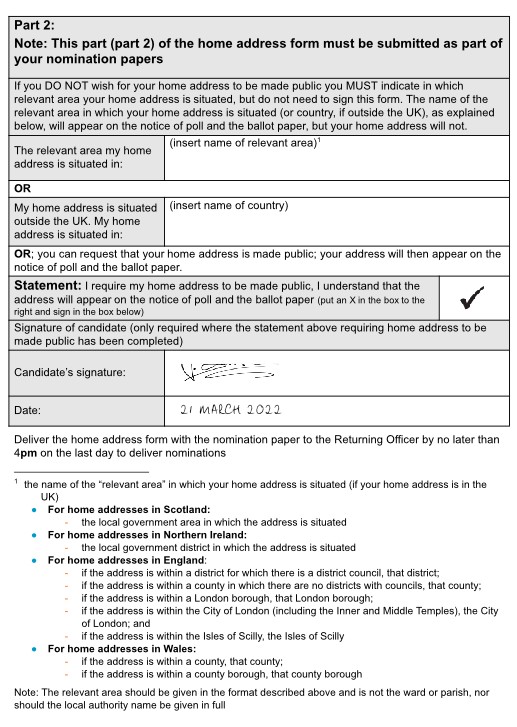
Certificate of Authorisation
This is the form that confirms you have permission to stand for the Liberal Democrats. As you are standing for the Liberal Democrats you must complete this form.
First of all enter the name of the Council, Ward and Polling Day date for your election.
To confirm your permission to stand for the Liberal Democrats this form needs to be signed by the party’s designated nominating officer for your area. You may already know who the Delegated Nominating Officer (DNO) to sign this in your area is – but if you do not you should contact your regional party or Sarah Morris on sarah.morris@libdems.org.uk.
You should then put ‘Liberal Democrats’ in the box for the registered political party.
If you used a different party description on your Nomination Form form – for instance the recommended ‘Scottish Liberal Democrats’ you must add the exact same description in the next box for party description. If the party description on the Nomination Form and Certificate of Authorisation do not match your paperwork will be invalid.
An example completed Certificate of Authorisation form is below:
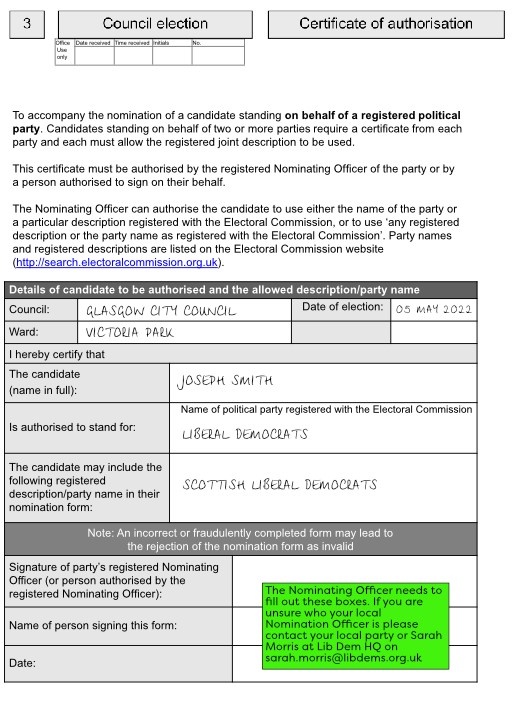
Request for a Party Emblem
This form allows the party’s ‘liberty bird’ emblem to appear alongside your name on the ballot paper.
Again, you should fill in the ward name and the date of polling day. You should then give your full name.
When giving the emblem description, use the exact Description. For Scotland this is:
- ‘A bird in flight above the words Scottish Liberal Democrats’ [Emblem ID 108]
An example form for the Scottish party logo is below:
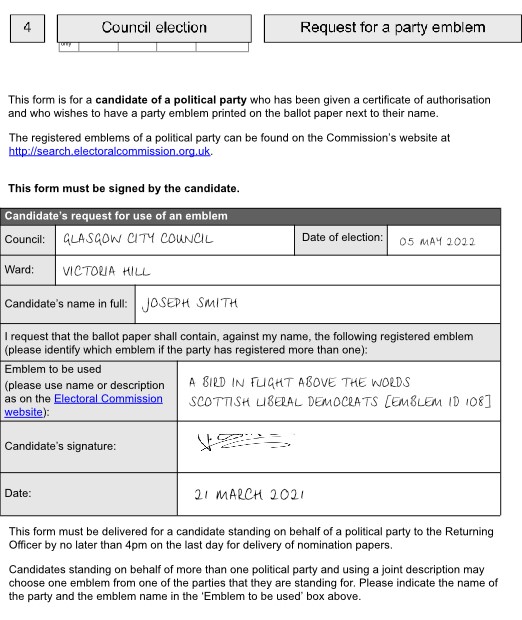
Notification of Election Agent
On this page, you can nominate your agent – the person legally responsible for your campaign and the return of your expenses forms after polling day.
You will see that you have to provide both your details and those of your agent. Ideally, your agent should have undertaken Election Agent training with the party or ALDC. You should always check with your intended agent before completing any part of this form.
You must provide your agent’s name, home address, and office address (for correspondence). Then your agent must sign and date their section.
An example Notification of Election Agent form is below:
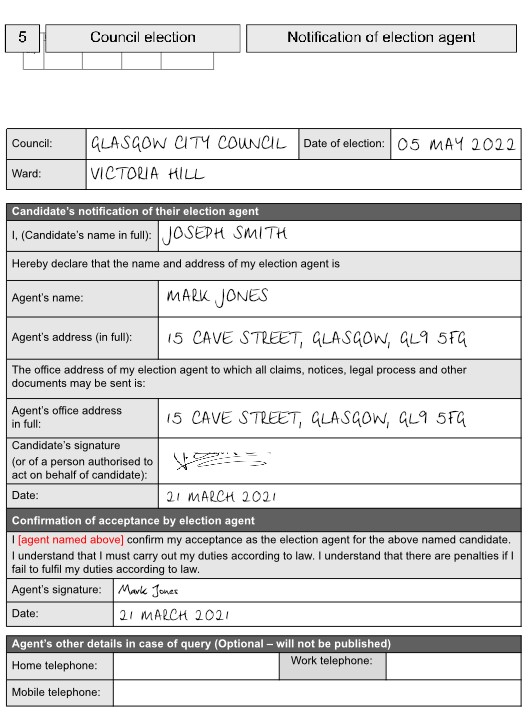
If you need advice and support on how to fill out your nomination forms, ALDC members can call our advice line between 9.30 and 5 Monday to Friday.